Anacardiaceae
Cashew family
Susan K. Pell- Anacardioideae
- Abrahamia ined.
- Actinocheita
- Amphipterygium
- Anacardium
- Androtium
- Apterokarpos
- Astronium
- Baronia
- Blepharocarya
- Bonetiella
- Bouea
- Buchanania
- Campnosperma
- Campylopetalum
- Cardenasiodendron
- Comocladia
- Cotinus
- Dobinea
- Drimycarpus
- Euroschinus
- Fegimanra
- Faguetia
- Gluta (including Melanorrhoea)
- Haplorhus
- Heeria
- Hermogenodendron ined.
- Holigarna
- Laurophyllus
- Lithrea
- Loxopterygium
- Loxostylis
- Malosma
- Mangifera
- Mauria
- Melanochyla
- Melanococca
- Metopium
- Micronychia
- Mosquitoxylum
- Myracrodruon
- Nothopegia
- Ochoterenaea
- Orthopterygium
- Ozoroa
- Pachycormus
- Parishia
- Pentaspadon
- Pistacia
- Protorhus
- Pseudosmodingium
- Rhodosphaera
- Rhus
- Schinopsis
- Schinus
- Searsia
- Semecarpus
- Smodingium
- Sorindeia
- Swintonia
- Thyrsodium
- Toxicodendron
- Trichoscypha
- Spondioideae
- Allospondias
- Antrocaryon
- Choerospondias
- Cyrtocarpa
- Dracontomelon
- Haematostaphis
- Haplospondias
- Harpephyllum
- Koordersiodendron
- Lannea
- Operculicarya
- Pegia
- Pleiogynium
- Poupartia
- Poupartiopsis
- Pseudospondias
- Sclerocarya
- Solenocarpus
- Spondias
- Tapirira
Introduction
Anacardiaceae, the cashew family, includes approximately 800 species in 82 genera. Members of the family are cultivated throughout the world for their edible fruits and seeds, medicinal compounds, valuable timber, and landscape appeal. Some of the products of Anacardiaceae, including mango (Mangifera indica), pistachio (Pistacia vera), cashew (Anacardium occidentale), and pink peppercorn (Schinus terebinthifolia), are enjoyed worldwide while other notables such as the pantropical Spondias fruits, the marula of Africa (Sclerocarya birrea), and the Neotropical fruits of Antrocaryon are restricted to localized cultivation and consumption and are not generally transported far distances to larger markets.
Characteristics
The Anacardiaceae includes primarily trees and shrubs (rarely lianas or subshrubs), with resin canals and clear to milky exudate. The leaves are estipulate, usually alternate (rarely opposite or whorled), and may be simple or pinnately compound (very rarely bi-pinnate; Spondias bipinnata). The flowers are generally not highly conspicuous but are distinctive in having an intrastaminal nectariferous disc and apotropous ovules (an ovule with a raphe that is ventral when ascending and dorsal when descending). Morphological fruit diversity is exceedingly high with a myriad of types found in the family.

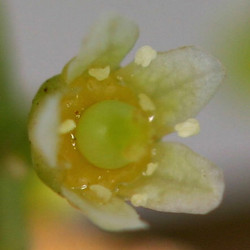
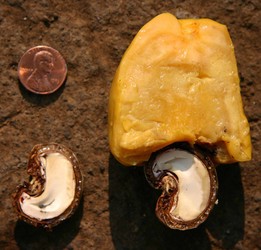
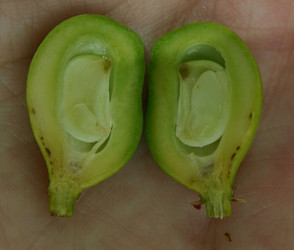
Flowers and fruits of Anacardiaceae: Flower of the pink peppercorn tree (Schinus terebinthifolia, left), fruit and subtending hypocarp of the cashew (Anacardium occidentale, center), and young mango (Mangifera indica, right) fruit showing the funicle (left section). ©
Although the majority of the family has drupaceous fruits, many of these are variously modified for different mechanisms of dispersal and several other fruit types are also represented. Two genera, Anacardium and Semecarpus, have an enlarged edible hypocarp subtending the drupe. One species of Anacardium, A. microsepalum, lacks the hypocarp and grows in the flooded forests of the Amazon where it may be fish dispersed (Mitchell and Mori, 1987; J. D. Mitchell, pers. com.). Water dispersal has been reported or purported for three genera, Mangifera, Poupartiopsis, and Spondias. The variety of mechanisms for wind dispersal include subtending enlarged sepals (Astronium, Loxostylis, Myracrodruon, Parishia), subtending enlarged petals (Gluta, Swintonia), trichome-covered margins on a globose fruit (Actinocheita), trichome-covered margins on a flattened fruit (Blepharocarya, Ochoterenaea), elm-like samaras with an encircling marginal wing (Campylopetalum, Cardenasiodendron, Dobinea, Laurophyllus, Pseudosmodingium, Smodingium), samaras with a single wing (Faguetia, Loxopterygium, Schinopsis), dry samara-like syncarps (multiple fruit, Amphipterygium, Orthopterygium), dry achene-like fruit (Apterokarpos), and elongated ciliate pedicles of sterile flowers on a tumbleweed-like infructescence (Cotinus).
Distribution
Anacardiaceae are found worldwide in dry to moist, mostly lowland habitats, primarily in the tropics and subtropics but extending into the temperate zone. The family is native to the western hemisphere (from southern Canada south to Patagonia), Africa, southern Europe, temperate and tropical Asia, tropical and subtropical Australia, and most of the Pacific Islands. Anacardiaceae are absent from northern Europe, temperate and arid Australia, New Zealand, the Galapagos Islands, and extreme desert and high elevation habitats (although they can reach elevations as high as 3,500 m).
References
Mitchell, J. D., and S. A. Mori. 1987. The cashew and its relatives (Anacardium: Anacardiaceae). Mem. NY Bot. Gard. 42: 1-76.
Title Illustrations

| Scientific Name | Toxicodendron diversilobum |
|---|---|
| Location | Tilden Regional Park, Berkeley, California, USA |
| Specimen Condition | Live Specimen |
| Body Part | leaves |
| Source | Poison Oak |
| Source Collection | Flickr |
| Image Use |
 This media file is licensed under the Creative Commons Attribution-NonCommercial-NoDerivs License - Version 2.0. This media file is licensed under the Creative Commons Attribution-NonCommercial-NoDerivs License - Version 2.0.
|
| Copyright | © 2008 Philip Bouchard |
| Scientific Name | Anacardium occidentale |
|---|---|
| Location | Belize |
| Specimen Condition | Live Specimen |
| Body Part | fruit |
| Source | Cashew Fruit2 |
| Source Collection | Flickr |
| Image Use |
 This media file is licensed under the Creative Commons Attribution-NonCommercial-NoDerivs License - Version 2.0. This media file is licensed under the Creative Commons Attribution-NonCommercial-NoDerivs License - Version 2.0.
|
| Copyright | © 2006 Dirk's Photography |
| Scientific Name | Spondias cytherea |
|---|---|
| Specimen Condition | Live Specimen |
| Body Part | fruit |
| Source | Kedondong IMG_0898B |
| Source Collection | Flickr |
| Image Use |
 This media file is licensed under the Creative Commons Attribution-NonCommercial-NoDerivs License - Version 2.0. This media file is licensed under the Creative Commons Attribution-NonCommercial-NoDerivs License - Version 2.0.
|
| Copyright | © 2007 Yeoh Thean Kheng |
About This Page

Brooklyn Botanic Garden, Brooklyn, New York, USA
Correspondence regarding this page should be directed to Susan K. Pell at
Page copyright © 2009
All Rights Reserved.
- Content changed 03 January 2009
Citing this page:
Pell, Susan K. 2009. Anacardiaceae. Cashew family. Version 03 January 2009 (under construction). http://tolweb.org/Anacardiaceae/21262/2009.01.03 in The Tree of Life Web Project, http://tolweb.org/




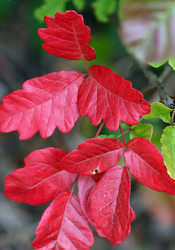
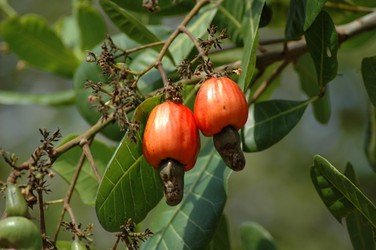
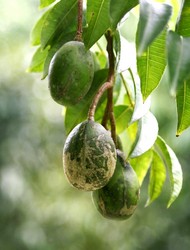





 Go to quick links
Go to quick search
Go to navigation for this section of the ToL site
Go to detailed links for the ToL site
Go to quick links
Go to quick search
Go to navigation for this section of the ToL site
Go to detailed links for the ToL site